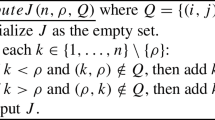Abstract
A flexible multi-client functional encryption scheme for set intersection (FMCFE-SI) [Rafiee, J. Supercomput 2023] is a cryptographic primitive that enables an evaluator to learn the intersection from any arbitrary subsets of a fixed client set, without need to learn the plaintext set of each individual client. In [Rafiee, J. Supercomput 2023], several security notions for FMCFE-SI, as well as the relations between them, are proposed. Constructing an FMCFE-SI with indistinguishability security against adaptive adversary (aIND) has remained as a challenging problem so far. In this paper, we propose a new FMCFE-SI construction to achieve this security notion in the random oracle model. We prove the security of our FMCFE-SI construction under Decisional Diffie–Hellman assumption in G1 (DDH1) in the bilinear groups. Our FMCFE-SI construction, compared to other existing constructions, does not increase the computational and storage overheads despite satisfying the stronger security notion.



Similar content being viewed by others
Data Availability
No datasets were generated or analyzed during the current study.
References
Kamara S, Mohassel P, Raykova M, Sadeghian S (2014) Scaling private set intersection to billion-element sets. In: Financial Cryptography and Data Security: 18th International Conference, FC 2014, Christ Church, Barbados, March 3-7, 2014, Revised Selected Papers 18, pp. 195–215 Springer
Seo JH, Cheon JH, Katz J (2012) Constant-round multi-party private set union using reversed laurent series. In: Public Key Cryptography–PKC 2012: 15th International Conference on Practice and Theory in Public Key Cryptography, Darmstadt, Germany, May 21-23, 2012. Proceedings 15, pp. 398–412 Springer
Katz J, Sahai A, Waters B (2013) Predicate encryption supporting disjunctions, polynomial equations, and inner products. J Cryptol 26:191–224
Sahai A, Waters B (2005) Fuzzy identity-based encryption. In: Advances in Cryptology–EUROCRYPT 2005: 24th Annual International Conference on the Theory and Applications of Cryptographic Techniques, Aarhus, Denmark, May 22-26, 2005. Proceedings 24, pp. 457–473 Springer
Boneh D, Sahai A, Waters B (2011) Functional encryption: Definitions and challenges. In: Theory of Cryptography: 8th Theory of Cryptography Conference, TCC 2011, Providence, RI, USA, March 28-30, 2011. Proceedings 8, pp. 253–273 Springer
Goldwasser S, Gordon SD, Goyal V, Jain A, Katz J, Liu F-H, Sahai A, Shi E, Zhou H-S (2014) Multi-input functional encryption. In: Advances in Cryptology–EUROCRYPT 2014: 33rd Annual International Conference on the Theory and Applications of Cryptographic Techniques, Copenhagen, Denmark, May 11-15, 2014. Proceedings 33, pp. 578–602 Springer
Chotard J, Sans ED, Gay R, Phan DH, Pointcheval D (2018) Decentralized multi-client functional encryption for inner product. In: International Conference on the Theory and Application of Cryptology and Information Security, pp. 703–732 Springer
Rafiee M (2023) Flexible multi-client functional encryption for set intersection. J Supercomput 79(12):13744–13765
Lee K, Seo M (2022) Functional encryption for set intersection in the multi-client setting. Designs Codes Cryptogr 90(1):17–47
van de Kamp T, Stritzl D, Jonker W, Peter A (2019) Two-client and multi-client functional encryption for set intersection. In: Australasian Conference on Information Security and Privacy, pp. 97–115 Springer
Boneh D (1998) The decision diffie-hellman problem. In: International Algorithmic Number Theory Symposium, pp. 48–63 Springer
SD, L.B.Ţ R.G, Moriai S (2019) Multi-client functional encryption for linear functions in the standard model from lwe. In: Advances in Cryptology–ASIACRYPT, vol. 2019
Regev O (2009) On lattices, learning with errors, random linear codes, and cryptography. J ACM (JACM) 56(6):1–40
Scott M (2002) Authenticated id-based key exchange and remote log-in with simple token and PIN number. IACR Cryptol ePrint Arch 2002:164
Rafiee M, Khazaei S (2021) Private set operations over encrypted cloud dataset and applications. Comput J 64(8):1145–1162
Du K, Wang J, Wu J, Wang Y (2024) Scalable equi-join queries over encrypted database. In: Proceedings of the 2024 on ACM SIGSAC Conference on Computer and Communications Security, pp. 4002–4016
Rafiee M (2023) Multi-adjustable join schemes with adaptive indistinguishably security. IEEE Transactions on Dependable and Secure Computing
Bera S, Prasad S, Rao YS (2023) Verifiable and boolean keyword searchable attribute-based signcryption for electronic medical record storage and retrieval in cloud computing environment. J Supercomput 79(18):20324–20382
Wu J, Zhang K, Wei L, Gong J, Ning J (2024) Practical searchable symmetric encryption for arbitrary boolean query-join in cloud storage. IEEE Trans Inf Forens Sec
Ballard L, Green M, de Medeiros B, Monrose F (2005) Correlation-resistant storage via keyword-searchable encryption. IACR Cryptol ePrint Arch 2005:417
Galbraith SD, Rotger V (2004) Easy decision Diffie-Hellman groups. LMS J Comput Math 7:201–218
Boneh D, Boyen X, Shacham H (2004) Short group signatures. In: Annual International Cryptology Conference, pp. 41–55 Springer
Ateniese G, Camenisch J, De Medeiros B (2005) Untraceable rfid tags via insubvertible encryption. In: Proceedings of the 12th ACM Conference on Computer and Communications Security, pp. 92–101
Camenisch J, Hohenberger S, Lysyanskaya A (2005) Compact e-cash. In: Annual International Conference on the Theory and Applications of Cryptographic Techniques, pp. 302–321 Springer
Lynn B (2006) The pairing-based cryptography library. https://crypto.stanford.edu/pbc/
Acknowledgement
This research was in part supported by a grant from IPM (No.1403940041).
Author information
Authors and Affiliations
Contributions
Since the author of the article is a single individual, all ideas and writing have been carried out by one person.
Corresponding author
Ethics declarations
Conflict of interest
The authors declare no conflict of interest.
Additional information
Publisher's Note
Springer Nature remains neutral with regard to jurisdictional claims in published maps and institutional affiliations.
Rights and permissions
Springer Nature or its licensor (e.g. a society or other partner) holds exclusive rights to this article under a publishing agreement with the author(s) or other rightsholder(s); author self-archiving of the accepted manuscript version of this article is solely governed by the terms of such publishing agreement and applicable law.
About this article
Cite this article
Rafiee, M. Toward more secure constructions of flexible multi-client functional encryption schemes. J Supercomput 81, 628 (2025). https://doi.org/10.1007/s11227-025-07112-1
Accepted:
Published:
DOI: https://doi.org/10.1007/s11227-025-07112-1




